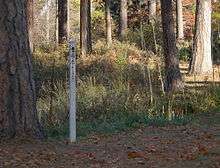Peace pole



A Peace Pole is a monument that displays the message "May Peace Prevail on Earth” in the language of the country where it has been placed, and usually 3 to 13 additional translations. The message often is referred to as a peace prayer, but sometimes it is not in order to avoid peace poles from being regarded as religious objects that violate zoning restrictions. A Quaker group in New York City ran into that problem year after year and never got permission to plant a peace pole in a park. At least one site refers to the phrase only as a Peace Message in order for there to be a reference to point to in such cases.[1]
The idea of Peace Poles was first thought up by Masahisa Goi in 1955 in Japan. The Peace Pole Project today is promoted by The World Peace Prayer Society as well as other groups and individuals. The first Peace Poles outside Japan were constructed in 1983.[2] Since then, more than 100,000 have been placed around the world in over 180 countries.[2]
Peace Poles are made of many materials. Most are made of wood. Others are made of limestone or copper or plastic or stainless steel. The text might be painted, carved, etched, welded, pasted, or riveted on. In some cases it merely is a plastic plaque attached with screws. In other cases it is the careful work of an artist or sculptor.
Peace Poles have been placed in such notable locations as the North Magnetic Pole, the Hiroshima Peace Memorial, and the site of the Egyptian Pyramids in Giza, the Aiki Shrine in Iwama, Japan,[3] as well as numerous community parks. Frequently they are placed near the entrances of churches or schools. In one case, a garden, created for a wedding, was designed around the Peace Pole that was its center piece. The Republic of Molossia, a micronation, has a Peace Pole in eight languages.[4] The University of California, Los Angeles has a limestone peace pole with 14 languages directly in front of Kerckhoff Hall.
Perhaps the world's largest Peace Pole, at 52 feet (16 m), is located in Janesville, Wisconsin at the site of a KKK rally. The initial inspiration for planting Peace Poles often is as a response to a local issue like a KKK rally. Another of the largest Peace Poles in the world, as measured in tons, is the granite Peace Pole[5] in Beech Acres Park[6] near Cincinnati, Ohio. The original inspiration for it was hate literature left in the driveways of Jewish residents.
See also
References
- ↑ "Peace Poles made by an Artist".
- 1 2 The World Peace Prayer Society
- ↑ Aikido Hawaii
- ↑ molossia.org
- ↑ the granite Peace Pole
- ↑ Beech Acres Park
External links
- http://www.worldpeace-uk.org/peacepoles/
- The World Peace Prayer Society page on Peace Poles
- The Global Heart page on Peace Poles
- The Peace Pole Makers USA
- Peace Poles Made by an Artist
- Janesville Public Parks
- Mapping Peace Poles around the World
| Wikimedia Commons has media related to Peace poles. |